



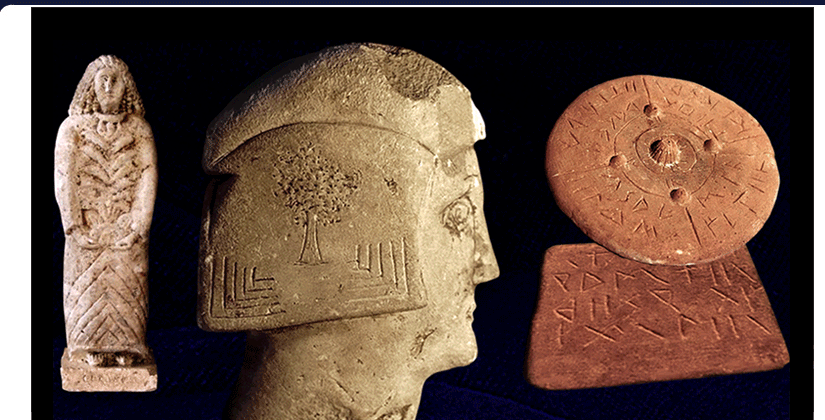
Resonance in Paleo-Sanskrit Texts from Malta and Caria, Italy
Mediterranean Paleo-Sanskrit Texts - Part 1
by Alex Putney for Human-Resonance.org
September 13, 2013
Distinct traces of the origin of all ancient hieroglyphic languages are perpetually emerging from the depths of large cave systems and from layers of soil deposited over ten thousand years ago. Careful investigation of physical remains left by Paleolithic cultures from every inhabited landmass reveals a wealth of artistic creativity that complimented a profoundly scientific worldview that was eloquently expressed in passages of pictographic script that can only now be understood in their proper context.
Only in the last few decades have multiple dramatic archeological discoveries in the Mediterranean region provided exquisite examples of inscribed artworks presenting spiritual perspectives from that far removed era. Throughout these texts, the status of infrasound resonance of the Sun, Earth and Jupiter are directly linked with the Great Pyramid, built by Atlantean engineers approximately 73,000 years ago.
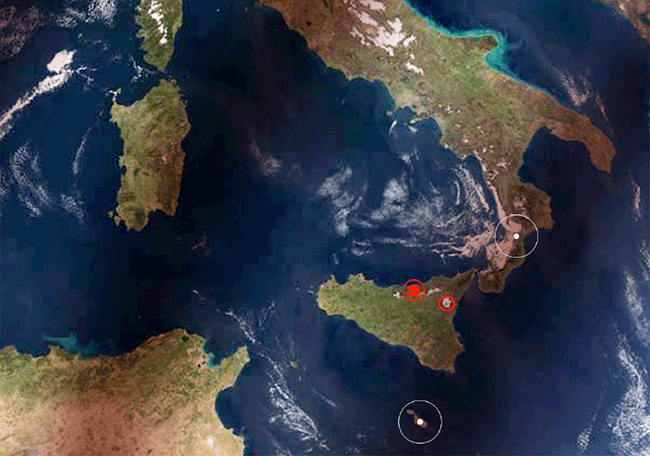
Analysis of the global distribution pattern of ancient pyramids, megaliths and sacred sites in all parts of the world have revealed their specific alignment in accordance with the foci of nonlinear standing waves transduced by the Great Pyramid in the ultra-low frequency range of the human heartbeat. This complex alignment also holds true for the geopositions of all Paleo-Sanskrit habitation sites discovered thus far in the Mediterranean region, especially on the Island of Malta and in nearby Calabria, Italy.
Planetary infrasound resonance is focused by the Great Pyramid into radial bands at Fibonacci intervals, as spherically mapped using the quadratic function [ zn+1 = zn2 ]. The resonant infrasound band centered on the 4.5% distance from the Great Pyramid influences Sicily's Mt. Etna volcano and also induces the spontaneous combustion of all electrical devices in nearby Messina (in red, above).
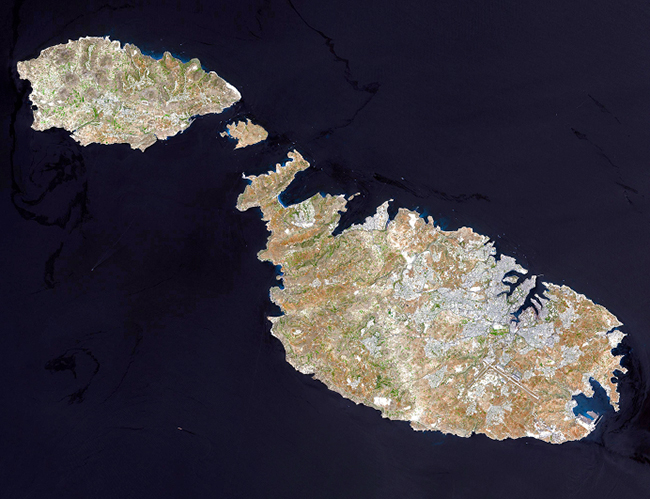
The Islands of Malta and Gozo (above, 36.10°N 14.10°E) are located 1,091 miles from the Great Pyramid, a distance that comprises 4.4% of the Earth's mean circumference distance. These islands are famous for a network of exquisitely hewn subterranean chambers and interconnecting tunnel systems that stretch for many miles below the limestone bedrock. Huge stone vaults containing unusual skeletal remains attest to genetic enhancement techniques using focused infrasound during fetal development, reflecting a strong maternal culture in which feminine energy was recognized as the primary Creative force, as exemplified by the Great Pyramid inscription: "From masculine, thundering granting feminine".
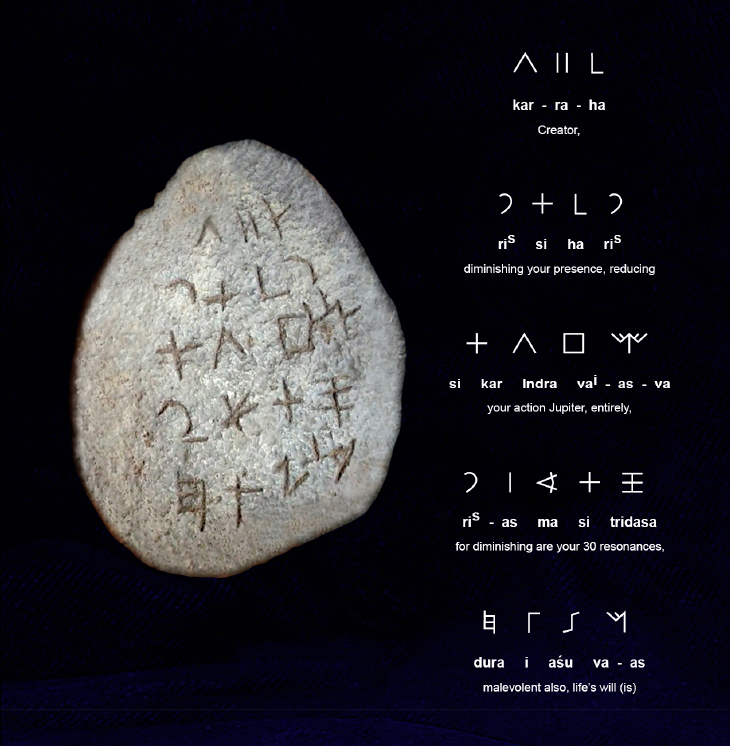
Of several stone and ceramic tablets found on this small Mediterranean island, and on the reefs just offshore, an image of only one engraved stone has been published as an online video. The oval-shaped stone tablet is quite flat, and very hard, and presents 20 glyphs separated into 5 lines of text that can be read from left to right as: karaha ris si ha ris si kar Indra vai-as-va ris-as ma si tridasa dura i asu va-as. Translation of the tablet according to the Schildmann decipherment provides the lamentation (above):
Creator, diminishing your presence, reducing your action Jupiter, entirely,
for diminishing are your 30 resonances, malevolent also, life's will is.
This statement repeats the same profound lamentation echoed throughout the many known collections of advanced Archaic Sanskrit works from the Paleolithic era, uncovered on all continents of the world and most explicitly expressed in thousands of stone texts from the Illinois cave archive. The maker(s) of the Malta stone tablet offer the precise terminology of Vedic science to specify an advanced concept related to the infrasonic function of the Great Pyramid that is not common knowledge at present.
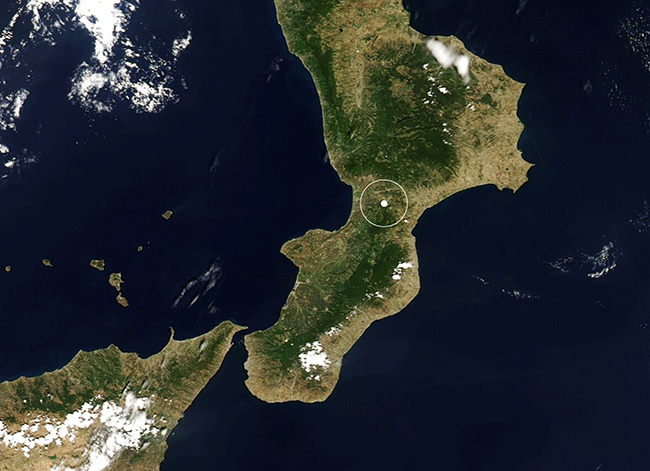
The largest collection of Paleo-Sanskrit artifacts known from the Mediterranean region was discovered accidentally in Calabria, Italy in 1971, near the hilltop town of Girifalco in Valle della Caria. A prolonged deluge of the area had caused severe erosion, with resulting landslides uncovering ancient relics that have become an intriguing and officially unacknowledged addition to the history of the Caria region.
The ancient remains were revealed as layers of soil were torn open like wounds on the land, having been seen by one of the first people to survey the landslide area. Inspection of the degraded hillsides was conducted for damage assessment by local lawyer Mario Tolone Azzariti, whose keen eyes spotted a limestone sculpture, one of many that would eventually be disinterred from the newly exposed site. Azzariti recovered the large stone object and cleaned off the red soil to expose the life-size features of a woman's head, enclosed in a strange angular helmet inscribed with pictograms for the Sun and the Tree.
After three decades of perseverance, planning and excavations without municipal financial support, Azzariti has recovered a few hundred items, many of which are inscribed with clearly defined lines of Paleo-Sanskrit text, now displayed in a modest museum in Girifalco, Italy. A video tour of the museum display presents dozens of stone axes, blades, loom weights and figurative sculptures, in addition to many fragmented ceramic tablets, cones and disks that have been painstakingly reassembled.
The excavation site near Girifalco in Valle della Caria, Italy (above, 38.82°N 16.40°E) is 1,037 miles from the Great Pyramid, or 4.2% of the Earth's mean circumference. This location provides for efficient reception of infrasound standing waves used to enhance consciousness and provide constant electrical power.
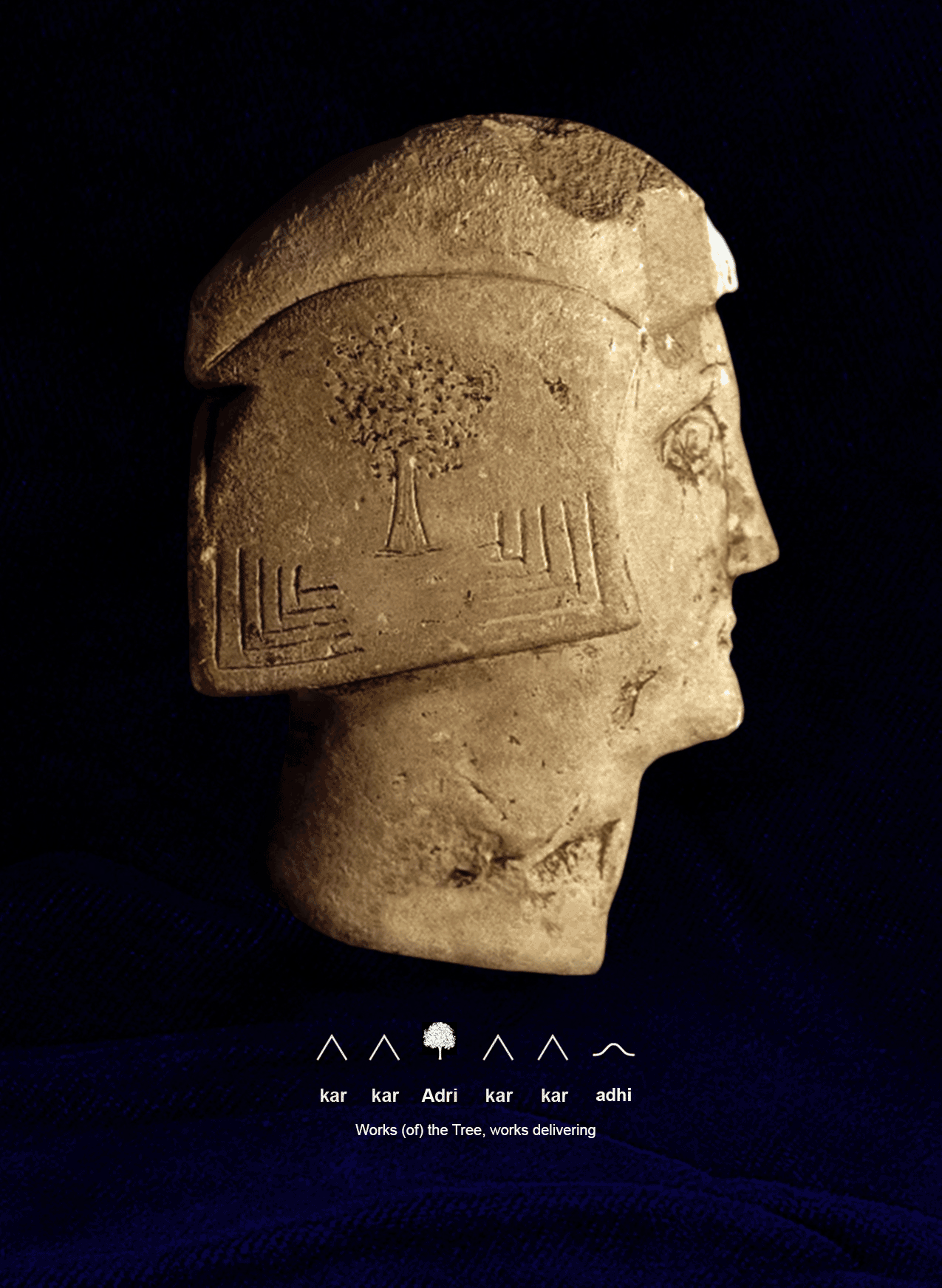
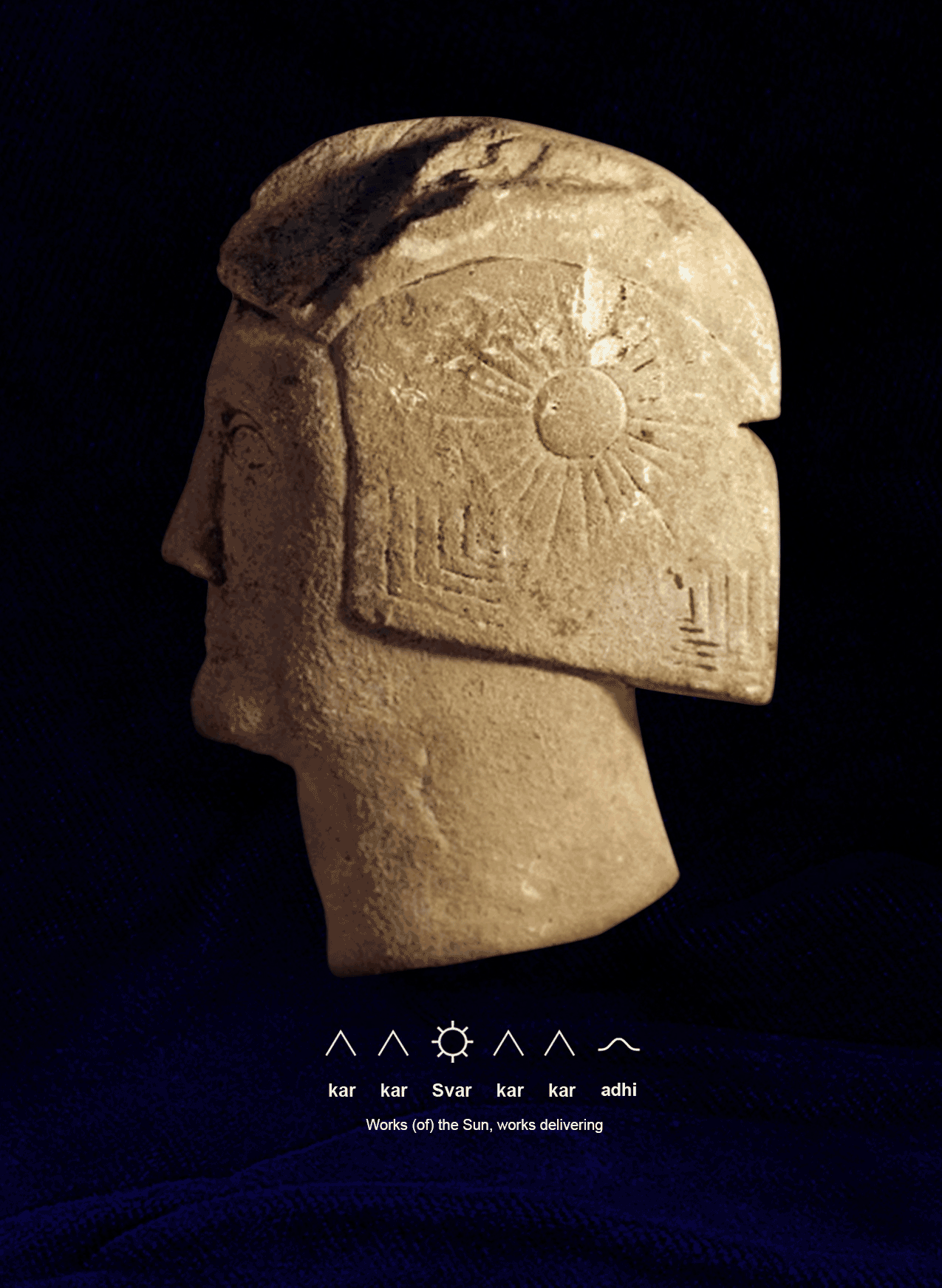
The initial discovery of the life-size limestone representation of the head of a woman wearing an unusual helmet shows technological features. Inscriptions confirm the psychoacoustic purpose of such helmets, made from resonant metal alloys with geometric forms that effectively focus infrasound waves for pineal synchronization. The helmet's right side bares the votive phrase: kar kar kar... Adri kar kar kar... adhi --"Works (of) the Tree, works... delivering". A complimentary text inscribed on the left side of the helmet reads: kar kar kar... Svar kar kar kar... adhi --"Works (of) the Sun, works... delivering" (above).

These Paleo-Sanskrit statements reflect an awareness of the beneficial infrasonic influence of tall trees upon human beings also preserved in the Vedic traditions of Siberia, as expressed by the forest sage Anastasia. The same profound knowledge of life force was expressed by the sage and healer known as Jesus, recorded in Aramaic texts comprising The Essene Gospel of Peace, entitled 'The Holy Streams':
Now in the hour before the rising of the sun, just before the angels of the Earthly Mother breathe life into the still sleeping earth, then do you enter into the Holy Stream of Life. It is your Brother Tree who holds the mystery of this Holy Stream, and it is your Brother Tree that you will embrace in your thought, even as by clay you embrace him in greeting when you walk along the lake shore. And you shall be one with the tree, for in the beginning of the times so did we all share in the Holy Stream of Life that gave birth to all creation. And as you embrace your Brother Tree, the power of the Holy Stream of Life will fill your whole body, and you will tremble before its might. Then breathe deeply of the angel of air, and say the word "Life" with the outgiving of breath. Then you will become in truth the Tree of Life which sinks its roots deep into the Holy Stream of Life from an eternal source. And as the angel of sun warms the earth, and all the creatures of land and water and air rejoice in the new day, so will your body and spirit rejoice in the Holy Stream of life that flows to you through your Brother Tree.
And when the sun is high in the heavens, then shall you seek the Holy Stream of Sound. In the heat of noontide, all creatures are still and seek the shade; the angels of the Earthly Mother are silent for a space. Then it is that you shall let into your ears the Holy Stream of Sound; for it can only be heard in the silence. Think on the streams that are born in the desert after a sudden storm, and the roaring sound of the waters as they rush past. Truly, this is the voice of God, if you did but know it. For as it is written, in the beginning was the Sound, and the Sound was with God, and the Sound was God. I tell you truly, when we are born, we enter the world with the sound of God in our ears, even the singing of the vast chorus of the sky, and the holy chant of the stars in their fixed rounds; it is the Holy Stream of Sound that traverses the vault of stars and crosses the endless kingdom of the Heavenly Father. It is ever in our ears, so do we hear it not. Listen for it, then, in the silence of noontide; bathe in it, and let the rhythm of the music of God beat in your ears until you are one with the Holy Stream of Sound. It was this Sound which formed the earth and the world, and brought forth the mountains, and set the stars in their thrones of glory in the highest heavens.
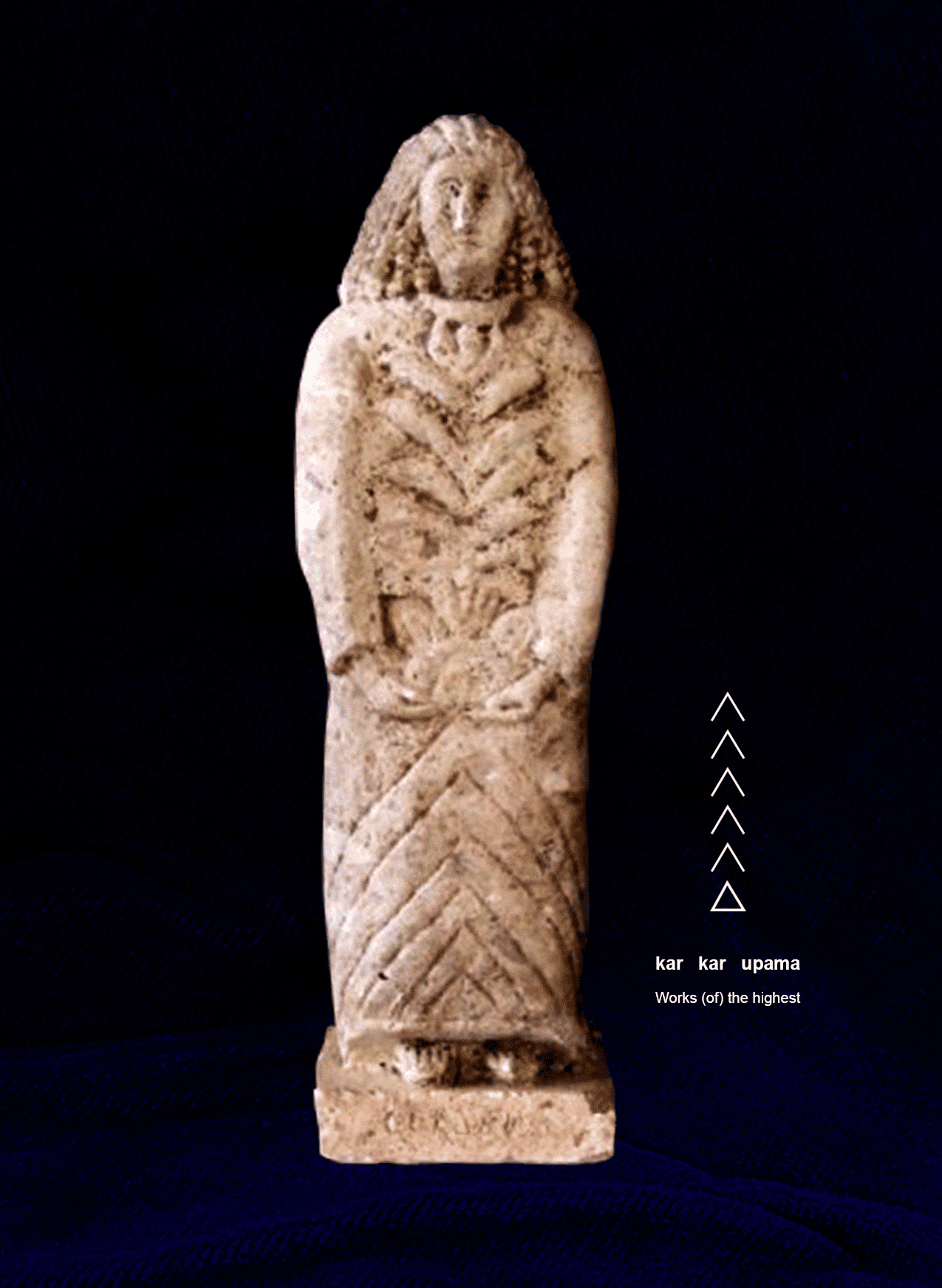
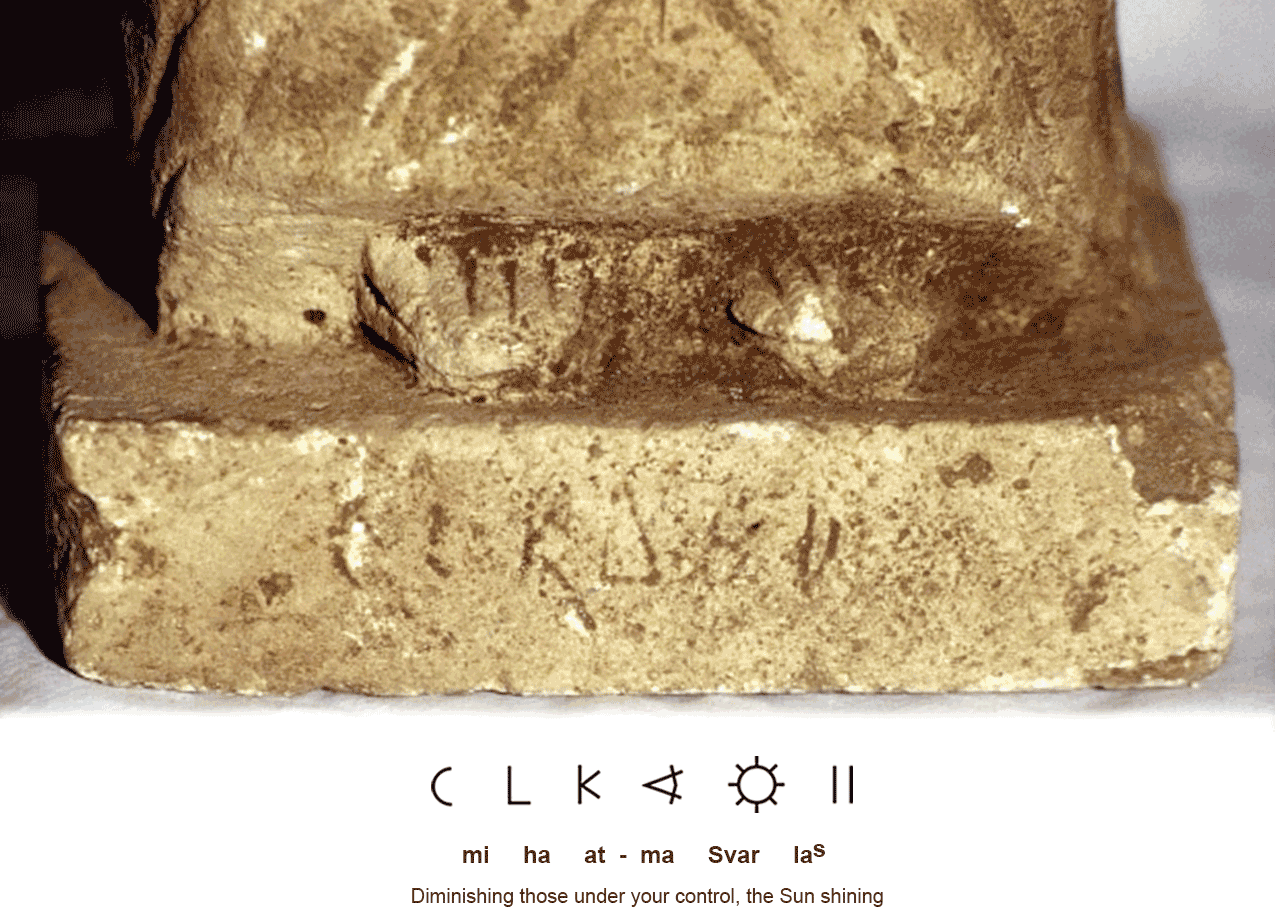
Among hundreds of Paleolithic artifacts from Caria, the largest stonework discovered thus presents a female figure with long curly hair and a long dress standing in a balanced, symmetrical pose, holding a clump of earth in her hands. The leafy stalk of a small plant rises from the soil as a feminine symbol of growth and fertility, and closely associated with the beautiful symmetry of resonant standing waves.
Below the plant, the patterning of the long dress present a vertical series of repeating 'kar' glyphs for 'works', rising above the triangular 'upama' glyph for 'the highest', representing the Great Pyramid. Referring to the vitalizing electro-acoustic function of the pyramid, the patternwork in the dress of the figure reads: kar kar kar kar kar upama --"Works of the highest" (above). The same vertical pictographic glyph group is engraved on a ceremonial calcite axehead from the Illinois cave archive that fluoresces brilliantly under ultraviolet light, as does the calcite-rich limestone of the Caria figure itself.
This sculpture visually expresses an Atlantean scientific and cultural awareness of the beneficial influence of infrasound resonance, bioelectrically enhancing the vitality, fertility and growth rates of plants, animals and human beings alike. A rough inscription on the front of the square base of the sculpture reinforces this interpretation of the highly advanced message expressed in the artwork, presenting 6 glyphs that read: mi ha atma Svar las --"Diminishing those under your control, the Sun shining" (above), identifying the offset status of planetary resonance as diminishing its beneficial action.
Surface texturing and rendering of the stonework's low relief suggest the piece was not carved from natural quarried stone. As with many other stone products of Atlantean origin, this sculpture appears to be synthetic limestone, having been mixed, poured and thermoset by a controlled chemical reaction within the mold. The limestone's exact density and composition may confirm its synthetic origin, while the plasticity of forms suggests the piece was sculpted in clay and cast in a simple 2-piece waste mold.
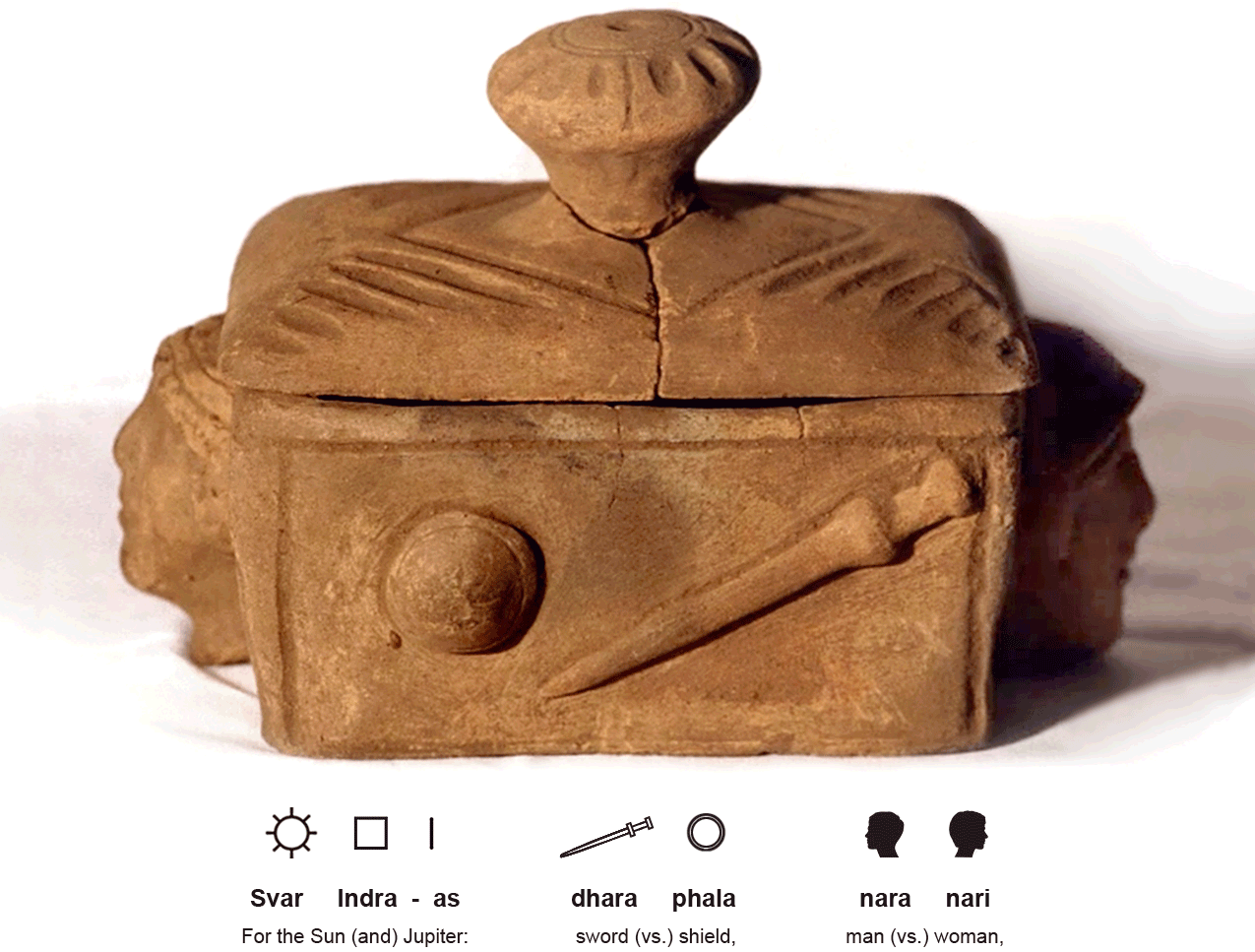
Enigmatic phrases used by Atlantean sculptors in Italy over 10,000 years ago reflect an advanced cosmological perspective that merges seamlessly with ancient hymns from the Vedas and Upanishads of India. Paleo-Sanskrit passages were also embedded in the design of practical ceramic objects.
The detrimental influences of planetary resonance upon human consciousness were expressed in high relief covering the visible surfaces of a square ceramic box with a fitted lid (above). The lid's mushroom-shaped handle is incised with the Sun glyph, while the square lid displays a large incised square with lines in four directions that together form the phrase: Svar Indra-as --"For the Sun and Jupiter".
The sides of the box juxtapose pictographic glyph pairs that continue the statement that begins on the lid. Clearly denoting armed conflict between human groups and domestic conflict between the genders, the glyph pairs read: dhara phala --"sword (vs.) shield", and nara nari --"man (vs.) woman".
The reverse side of the square ceramic box presents a pictogram in relief below a clear line of glyphs (opposite). The dominant adhi glyph meaning 'delivering' has been inverted, and along the full length of its curve is a repeating series of glyph pairs, a dot signifying the number '1' and a line representing the 'as' glyph, meaning 'for'. Thus the repeating glyph pairs read: "for the one, for the one, for the one..."
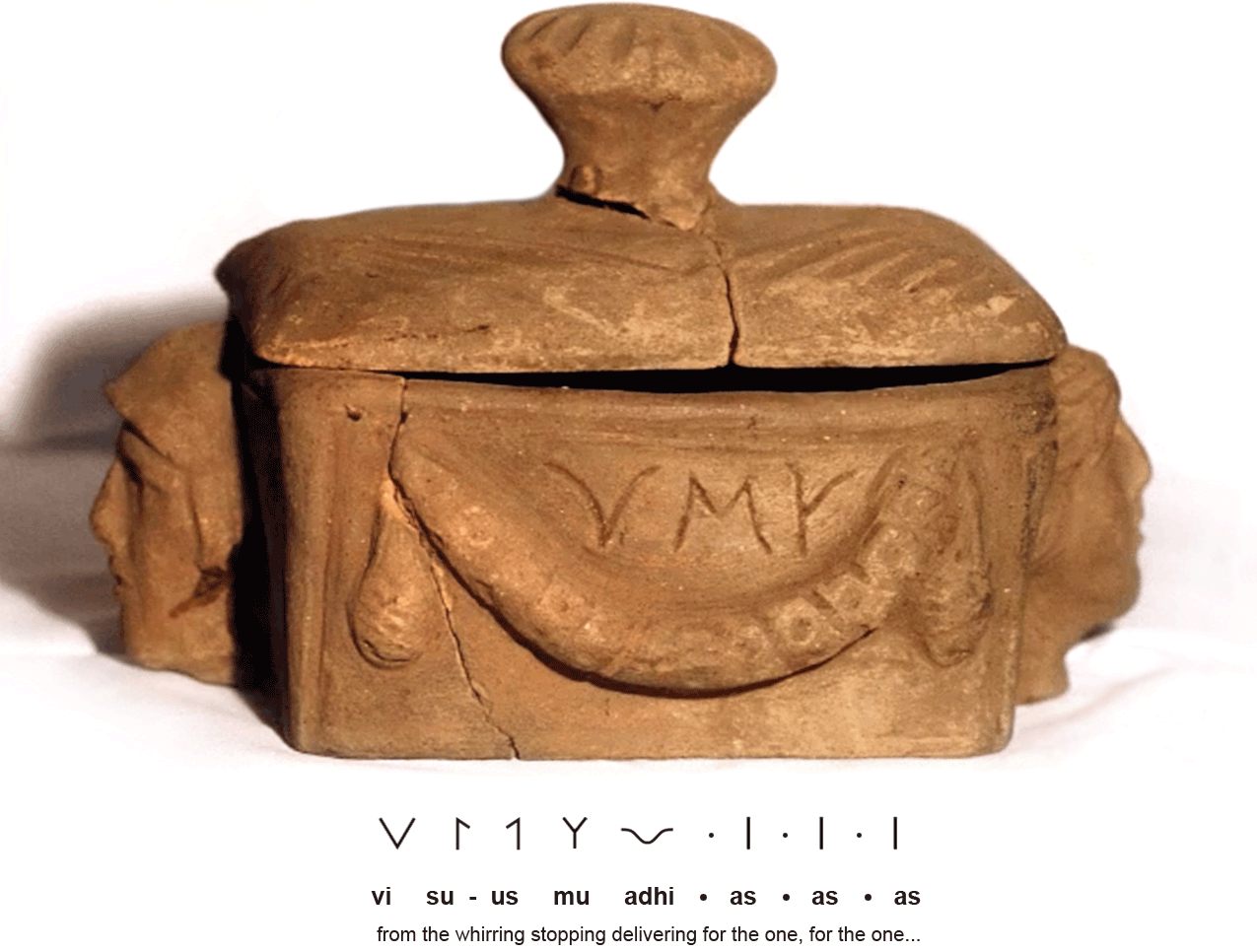
When combined with the surmounting line of glyphs, this panel reads: vi su-us mu adhi * as * as * as -- "from the whirring stopping delivering for the one, for the one..." (above). This statement echoes other texts from Caria in referencing the malevolent action incurred by the greatly diminished state of resonant infrasound whirring from the Sun and Jupiter. This final panel completes the full explanatory statement:
For the Sun and Jupiter: sword vs. shield, man vs. woman, from the whirring stopping delivering for the one...
Understood within the proper framework of planetary resonance, this profound statement accurately identifies the root cause of all strife in our world --from the quarreling of spouses to the warring of groups and nations alike-- as induced by the diminished state of planetary infrasound resonance. The depiction of water vapor falling as droplets on either side of the standing wave 'delivering' glyph also references the thick water vapor canopy once suspended aloft by the operation of the pyramid network. This text echoes powerful statements of the Maya descendant culture, as preserved and skillfully translated from original Maya glyphs into Spanish and English, and recently published as The Pyramid of Fire Codex:
Man does not will when he wars, loves and reaps; it is the rhythm of the great gods, the planets, that act over him and make him do. When man comprehends that by himself he can do nothing, then he can learn to serve the gods; so, he must become conscious of the rhythms of the gods.
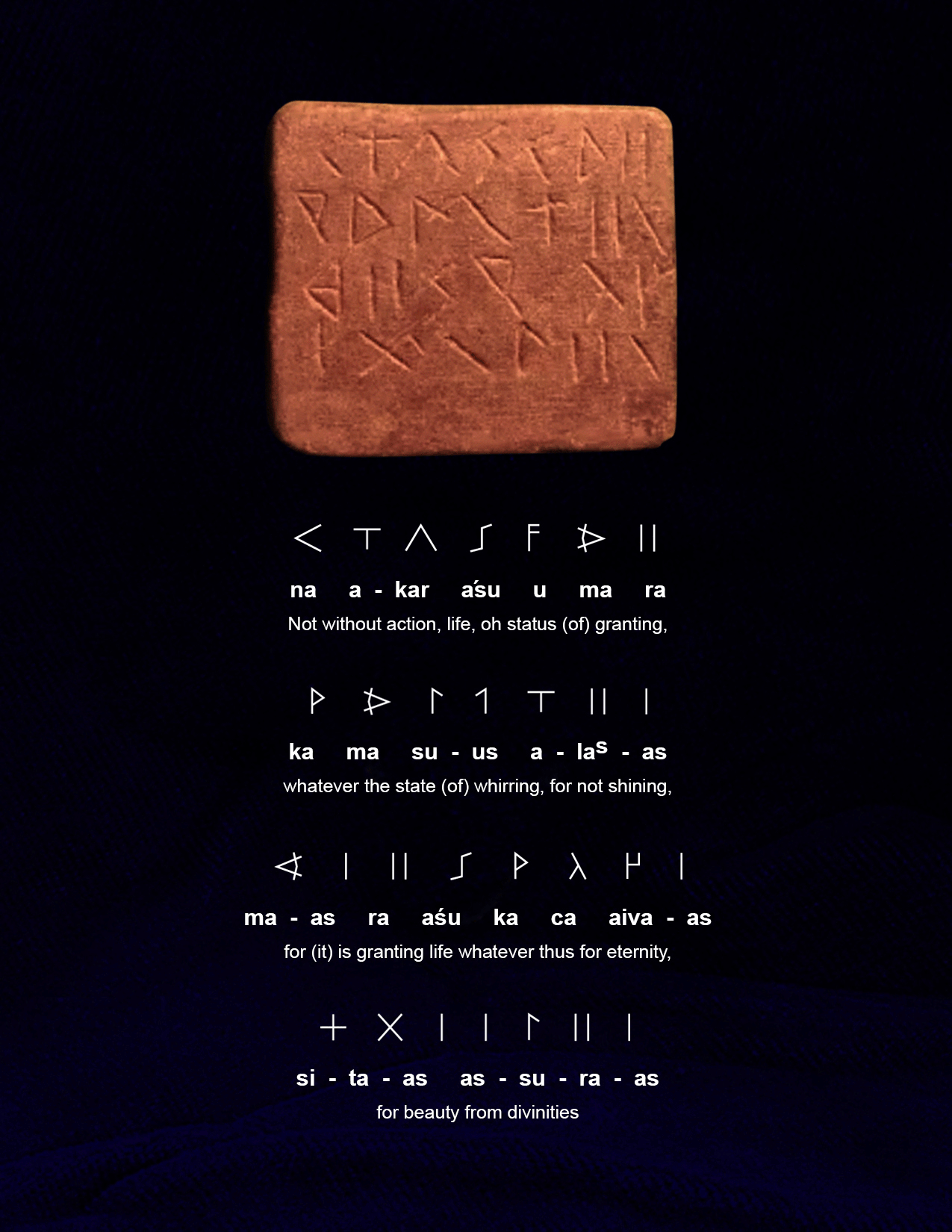
Several other texts with profound laments preserved in the Caria museum collection closely reflect the enigmatic sentiments expressed in the Illinois cave archive texts. A variety of terracotta tablets and mandalas have been recovered at Caria, the largest of which were carefully reassembled from dozens of fragments, preserving precious inscriptions that elucidate our deeper past.
A perfectly intact rectangular clay tablet presents four lines of glyphs that read from left to right (above), as supported by the staggered alignment of the characters on the left side of the plate. The votive passage reads:
na akar asu u ma ra ka ma su-us alas-as
ma-as ra asu ka ca aiva-as sita-as asura-asNot without action, life, oh status of granting,
whatever the state of whirring, for not shining, for it is
granting life whatever thus for eternity, for beauty from divinities.
Once again, Schildmann's decipherment provides clear translations for key cultural phrases that closely reflect statements from Paleo-Sanskrit artifacts from other continents, altogether dwelling on the subject of the diminishing state of planetary infrasound resonance and detrimental effects upon consciousness and longevity.
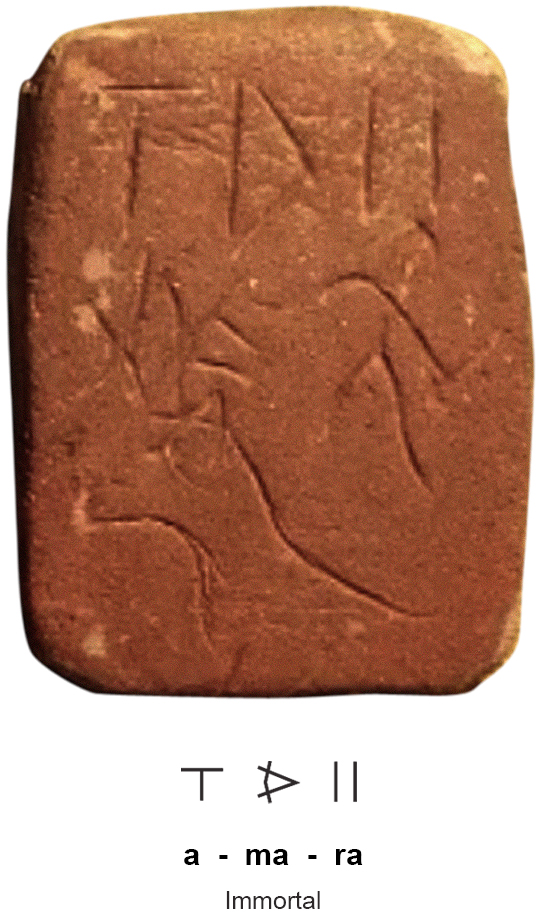
Another classic Sanskrit theme that cannot be adequately understood outside the constructs of Vedic tradition is the notion of reincarnation, which appears on another clay tablet from Caria (above). This depiction of a hunting scene with a man and a buck is surmounted by a three-glyph line reading: amara --"Immortal".
The ancient and widespread indigenous cultural acknowledgement of the continual reincarnation of all living organisms, each according to its own level of consciousness, reflects a broader awareness of the eternal transcendence of Spirit over the material body. Providing a deeper Vedic spiritual perspective, the text line above the pictograms denies a materialistic view of the close relationship of hunter and prey.
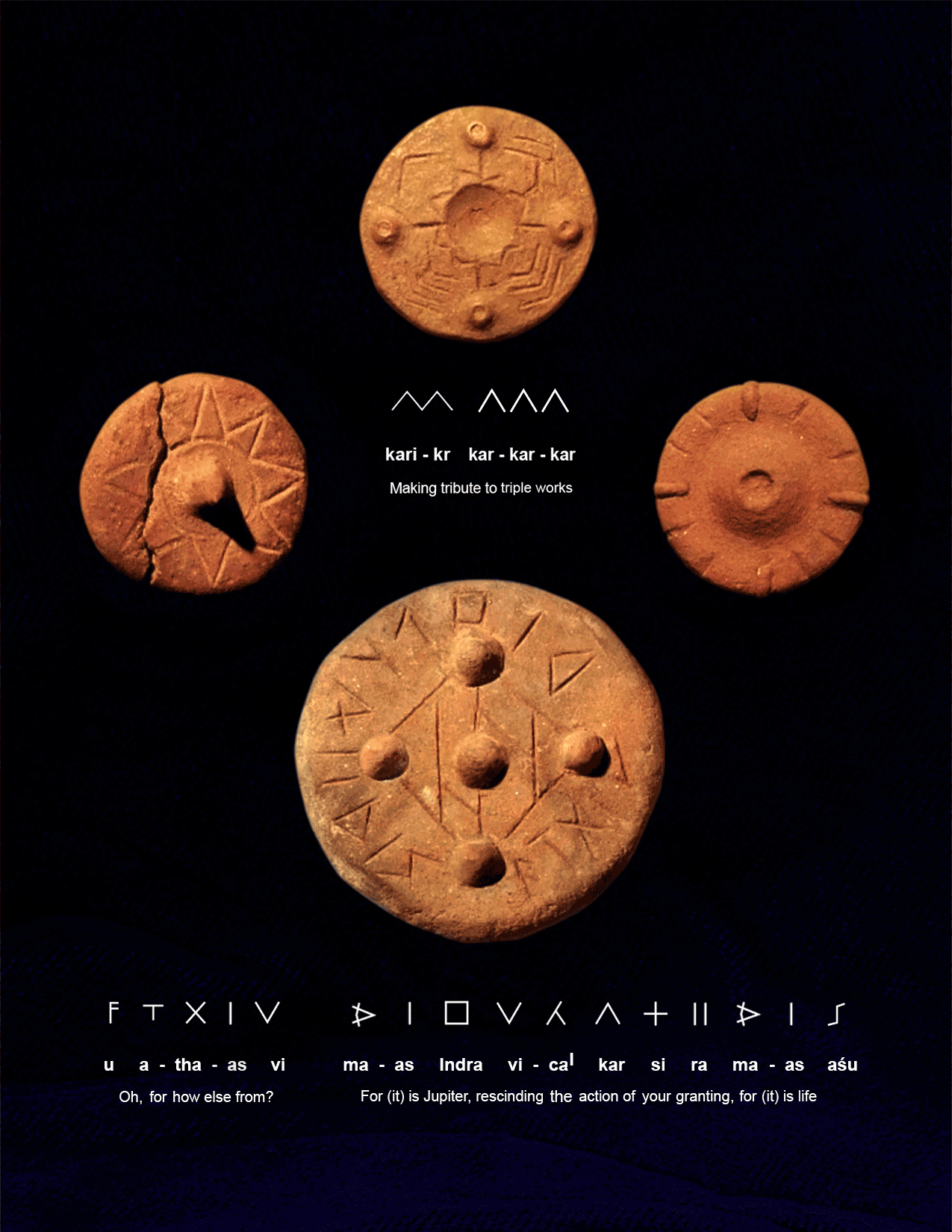
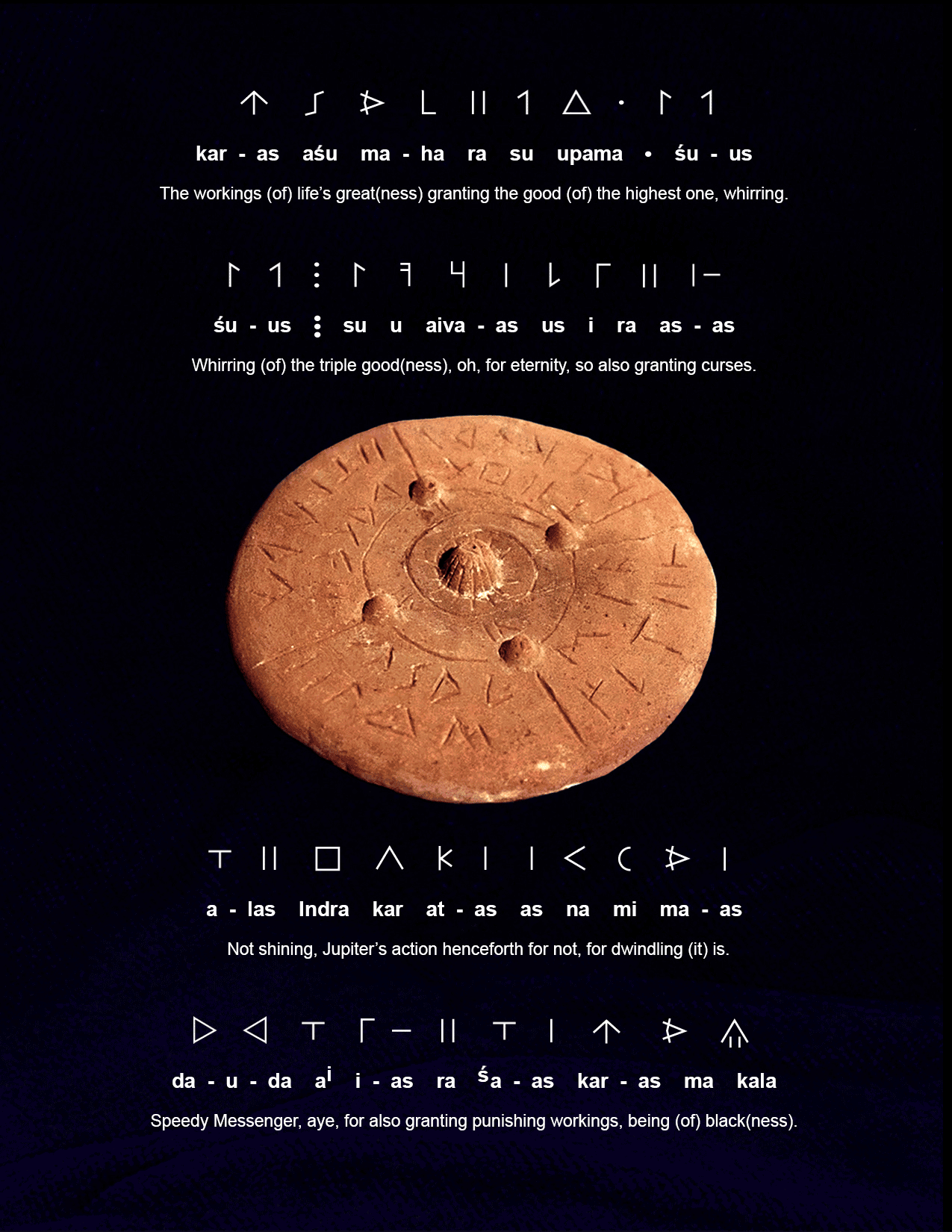
Several terracotta disks carefully delineated with octagonal mandala that reflect the structure of standing wave resonance, and have been inscribed with four sets of glyphs, still legible despite the passage of several millennia. The basic phrase reads: karikr kar kar kar --"Making tribute to triple works" (above, left). A larger ceramic mandala disk has been inscribed with a lamentation that echoes the others:
u atha-as vi
ma as Indra vical kar si ra ma-as asuOh, for how else from? For it is Jupiter,
rescinding the action of your granting, for it is life.
Further explanations are provided by the largest of the mandala disk texts, which expresses four clear statements concerning the malevolence induced by the dysfunction of the Great Pyramid and blackness of the subdued state of planetary infrasound resonance influencing our entire solar system (above, right):
The workings of life's greatness granting the good of the highest one, whirring.
Whirring of the triple goodness, oh, for eternity, so also granting curses.
Not shining, Jupiter's action henceforth for not, for dwindling it is.
Speedy Messenger, aye, for also granting punishing workings, being of blackness.
This phrase references the deified planet Mercury, named the Speedy Messenger for it possesses the shortest orbital period around the Sun of all planets, with a sidereal orbit corresponding to 88 Earth days.
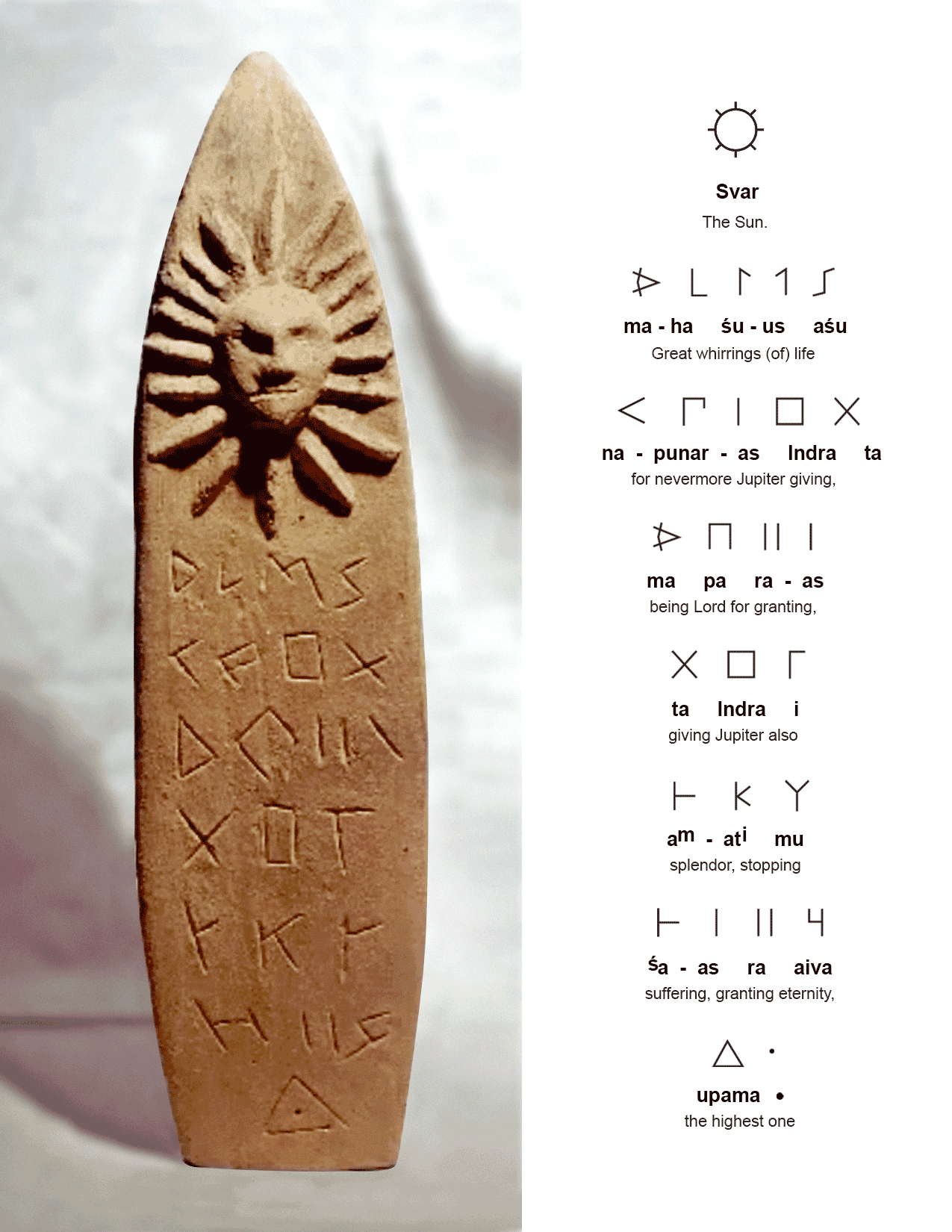
Svar maha su-us asu na-punar-as Indra ta ma pa ra-as
ta Indra i amati mu sa-as ra aiva upama *The Sun. Great whirrings of life for nevermore Jupiter giving, being Lord of granting,
giving Jupiter also splendor, stopping suffering, granting eternity, the highest one.
Once again, we see the remarkable consistency of the complex meaning being expressed by every Atlantean group at this time in remote history, expressing a profound awareness of the biophotonic function of all life and its direct coupling to planetary infrasound resonance that had been enhanced by the Great Pyramid.
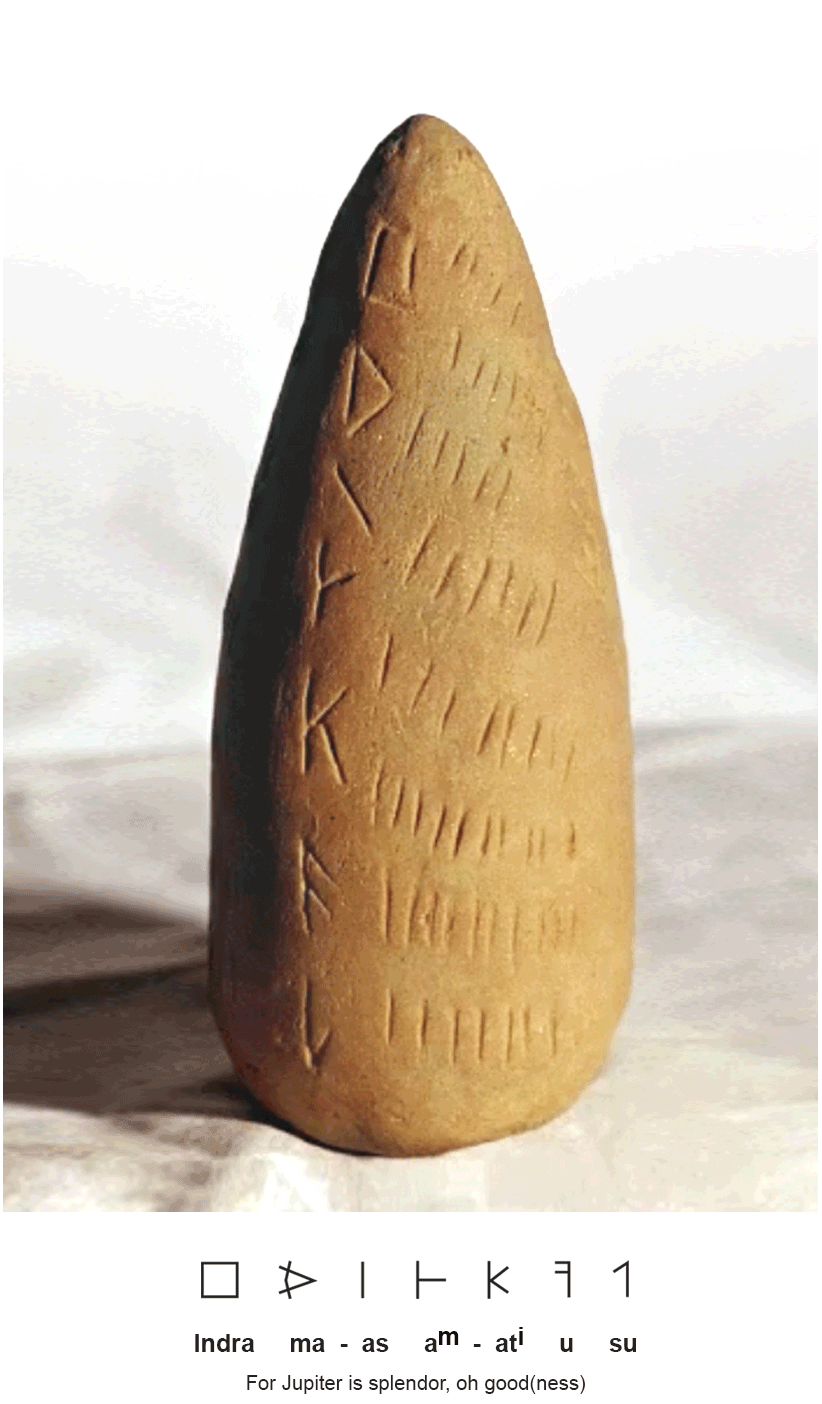
The many sorrowful lamentations are accompanied by more positive statements, one of which was neatly inscribed into a ceramic object that may have been used as a healing tool within resonant chambers (above). Ceramics are good conductors of electricity because of their high content of sand (quartz), iron and other metal particles, and were used by Atlantean healers to transduce resonant infrasound for amplifying electromagnetic qi healing methods still applied today by adepts.
The beneficial effects of the ultra-low frequency thundering of the Sun and Jupiter were scientifically understood by this advanced Vedic motherculture as enhancing the luminosity of the human body through bioelectrical excitation of resonant nuclear reaction cascades that cause the body to glow in synchrony with the complex movements of the planets overhead. Healing tools used to focus electro-acoustic energy describe this invisible influence directly when praising the planets and the Sun as deities granting life force. Reading from top to bottom, a vertical column of 7 glyphs extols the planet Jupiter with the phrase: Indra ma-as amati u su --"For Jupiter is splendor, oh goodness." Rows of vertical lines to the right reinforce the sentiment, repeating the same glyph: ra ra ra ra ra --"Granting, granting, granting..." (above).
The simplicity of this logographic script and the brevity of many of the texts themselves belies the exceedingly profound scientific level of understanding that prevailed among Atlantean peoples from all continents, reflecting their everyday use of highly advanced technological devices. The motherculture of Atlantis overshadows all our present technological developments by revealing the physics of life force.
From the book Sanskrit
Continue to Mediterranean Texts - Part 2
Return to The Illinois Archive - Part 1 & Part 2
Copyright 2013-2015 Alexander Putney